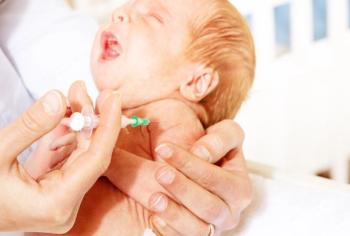
SFN: Communication Poor Within Autistic Brains
ATLANTA -- Brain regions of adults with autism fail to communicate efficiently with one another, according to high-resolution electroencephalography findings.
ATLANTA, Oct. 18 -- Brain regions of adults with autism fail to communicate efficiently with one another, according to high-resolution electroencephalography findings.
Examining connections in the cerebral cortex of patients with autism spectrum disorders with high-resolution EEG, Michael Murias, Ph.D., of the University of Washington Autism Center in Seattle, and colleagues, reported here they found weak connectivity between the frontal lobe and the rest of the cortex.
They also found that neural connectivity was elevated within the left hemisphere temporal and frontal regions of people with autism compared with non-autistic adults, suggesting a possible focus for autism-related language deficits, the investigators said at the Society for Neuroscience meeting here.
"Our findings indicate adults with autism show differences in coordinated neural activity, which implies poor internal communication between the parts of the brain," said Dr. Murias.
The findings could lead to the development of biologic markers for autism, the investigators suggested.
They used high-resolution EEG to map and compare coherence between electrode pairs in 18 adults with autism and 18 non-autistic controls.
"Coherence is primarily a measure of phase correlation, believed to reflect functional cortical connectivity either directly (via corticocortical fiber systems) or indirectly (through networks that include other cortical or subcortical structures)," the investigators wrote in a poster presentation.
The study participants, who ranged in age from 18 to 38 years, all had full scale IQ and verbal IQ scores above 80 on the Wechsler Adult Intelligence Scale.
Participants with autism were diagnosed with the Autism Diagnostic Interview Revised, the Autism Diagnostic Observation Schedule Module 4, and clinical judgments based on DSM-IV criteria for the presence of autism spectrum disorder.
The brain activity of the volunteers was recorded, while they were resting with their eyes closed for two minutes, a with 124-channel continuously recorded EEG.
The investigators found that in the upper delta and lower theta frequencies (3-6 Hz), the adults with autism had elevated coherence (indicating higher than normal connectivity), especially within the temporal and frontal regions of the left hemisphere.
In contrast, in the lower alpha range (8-10 Hz), they saw the adults with autism had reduced coherence relative to controls both within frontal regions and between the frontal and all other scalp regions.
The autism spectrum disorder group also exhibited significantly greater relative power between 3-6 Hz and 13-17 Hz, and significantly less relative power in the 9-10 Hz range (all P<0.025).
The alpha band findings indicated a global pattern of decreased neural connectivity between the frontal lobes and the rest of the autistic brain.
"Globally reduced 8-10 Hz coherence is consistent with recent regional cerebral blood flow studies, and suggests that the frontal lobe in autism spectrum has weak functional connections with the rest of the cortex in the lower alpha range," the authors wrote.
The finding, if supported by other research, suggests that differences in coherence patterns could serve as potential markers for autism, and could help to define the autistic phenotype, according to University of Washington researchers. The research also has implications for possible diagnosis and early intervention in young children with autism spectrum disorders.
The study was funded the National Institute of Mental Health's Studies to Advance Autism Research and Treatment, and the Perry Research Fellowship Endowment.
Newsletter
Enhance your clinical practice with the Patient Care newsletter, offering the latest evidence-based guidelines, diagnostic insights, and treatment strategies for primary care physicians.


















































































































































































































































































